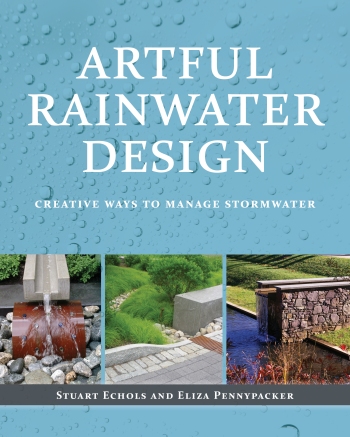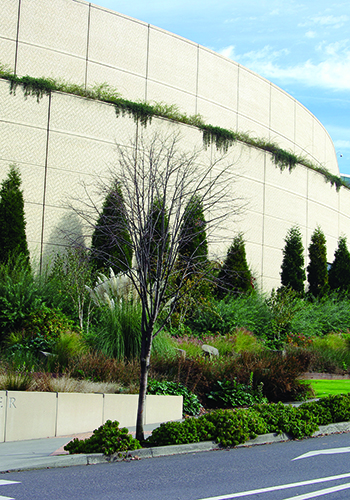The Drain Gain: Art and An End to Forgettable Stormwater Management
As our climate becomes more unpredictable, finding better ways to manage stormwater is crucial to mitigating flood damage. However, traditional stormwater management strategies can be unforgettable at best and unsightly at worst. In the new book, Artful Rainwater Design: Creative Ways to Manage Stormwater, authors and Pennsylvania State University professors, Stuart Echols, ASLA, and Eliza Pennypacker, ASLA, prove that this doesn't always have to be the case — it is possible to effectively manage runoff without sacrificing aesthetics.
In this well-organized how-to guide for designers, Echols and Pennypacker highlight the benefits of Artful Rainwater Design (ARD), a term coined by Echols in 2005 to describe rainwater collection systems that are not only functional, but also attractive and engaging. These systems are usually designed to handle small rain events and the initial — and dirtiest — events, rather than major flooding from large storms. Given these smaller rain events of up to 1-½ inches typically account for 60-90 percent of all precipitation, the authors advocate ARD as "the new normal of runoff management."
Beginning with a history of traditional approaches, then transitioning to the landscape amenity and utility values provided by ARDs, and, finally, concluding with 20 case studies, the book makes a convincing argument for ARDs as a stormwater management strategy. Echols' and Pennypacker's most compelling assertion is that creative, attention-grabbing stormwater management techniques do more than simply add aesthetic value to a landscape — they also serve as a reminder that rainwater is a valuable resource that feeds plant life and replenishes terrestrial water sources. In this way, ARDs can be used to "advance the agenda of environmentally-responsible design by making systems not only visible and legible, but beautiful."
While some sections of the book may appear redundant with existing stormwater management guides, the book is effective as an inspiring catalog of successful ARDs. Echols and Pennypacker first consider existing ARD projects for their general landscape amenities — a difference from existing resources that typically consider stormwater strictly as a problem in need of solving. The authors list the facets of many public ARDs, such as education, recreation, safety, public relations, and aesthetic richness, and they include several examples.
Among the more innovative projects highlighted in this section is the new Queens Botanical Garden Visitor Center in Flushing, New York, by Atelier Dreiseitl with Conservation Design Forum and BKSK Architects, which provides opportunities for people "to splash, float objects, or just watch the water."
But are these amenity-providing ARDs as effective at managing stormwater as traditional methods? When considered as a starting point for site design, Echols and Pennypacker argue that ARDs can actually accomplish much more than existing strategies. They can reduce pollutant loads in rainwater, restore or create habitat, and capture water for reuse (among other goals).
Standout projects in this section include the "Beckoning Cistern" by Artist Buster Simpson. This project refers to Michelangelo's painting of God's life-giving touch, with Adam's outstretched finger — but in this case, roof runoff is the life source and is collected into a container.
Most landscape architects will likely agree with Echols' and Pennypacker's arguments in favor of ARDs. As Warren Byrd, FASLA, of Nelson Byrd Woltz, asks in the first chapter: "Why wouldn't we use ARDs?" But the question remains: Why aren't ARD systems more widely implemented?
Though ARD is a fairly recent design concept, many designers currently see ARDs as too expensive, too difficult to get through the approval process, or, more often than not, not appropriate for their geographical area. While about half of the designs featured in the book are located in Seattle, Washington, and Portland, Oregon, the authors urge readers not to consider these examples as "'out there' and irrelevant to [their] own contexts" — these cities were simply ahead of the curve. As Steve Law from the Portland Tribune writes, "Across the nation more than 700 cities have combined sewer overflow problems, largely communities that developed a century or more ago, like much of Portland."
Echols and Pennypacker also assuage fears over the time and energy that can go into maintaining ARDs, offering several solutions, such as using edging to differentiate between landscapes that demand weekly maintenance (mowed lawn) from those that demand monthly maintenance (rain gardens). This strategy was successfully employed at the Oregon Convention Center, one of the featured case studies, which was designed by landscape architecture firm Mayer/Reed.
In a conversational conclusion, Echols and Pennypacker are honest about the many challenges ARDs pose at this point in the history of sustainable design. However, at a time when doing nothing to manage rainwater is simply not an option, their book instills hope that the days of drab detention ponds may soon be coming to an end, ushering in a new era of rain-celebrating landscapes.
Related articles:
- How Greening Our Streets Can Also Make Them More Resilient to Extreme Weather
- The Benefits of Green Infrastructure in Cities
- Urban Vegetation and Health and Tackling Pollution
- Why Green Infrastructure Makes Cities Awesome
- It's Definitely Time to Rethink the Parking Lot
- Clean Water Services - Field Operations Center
- What Makes a Street Green?




